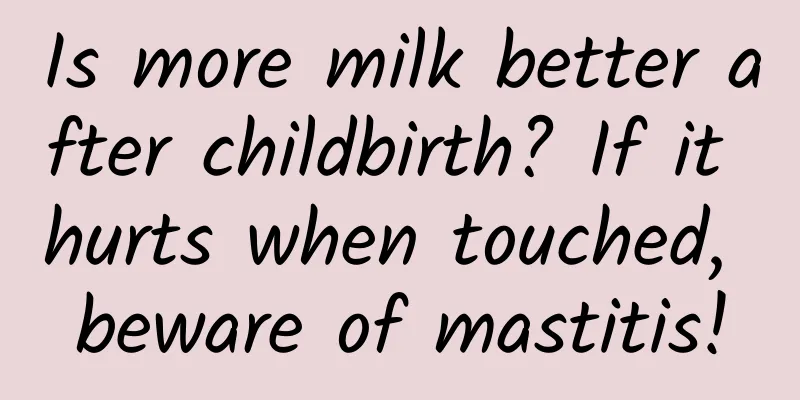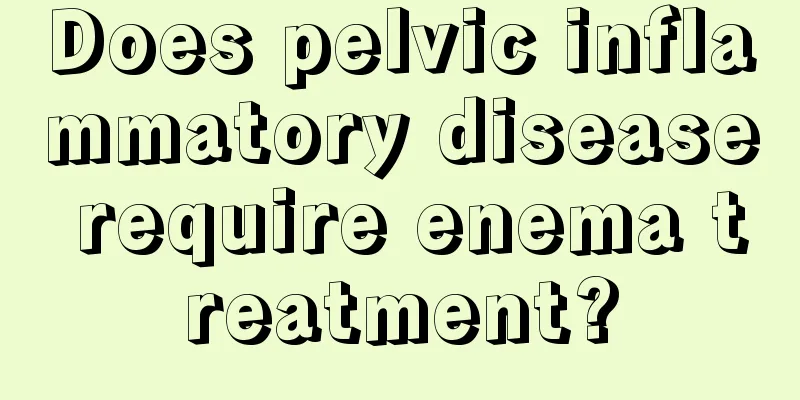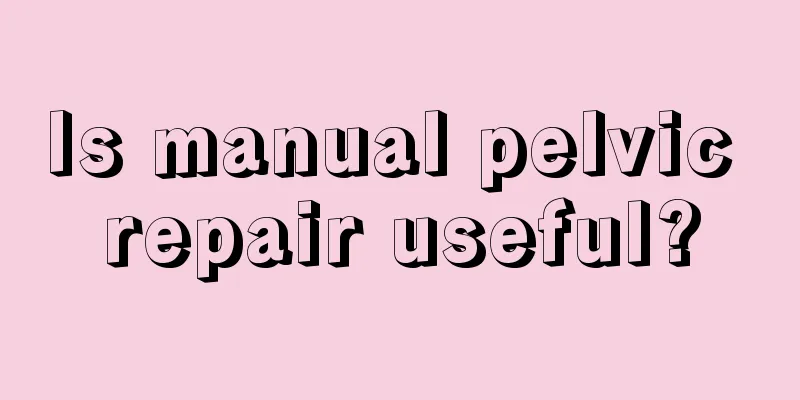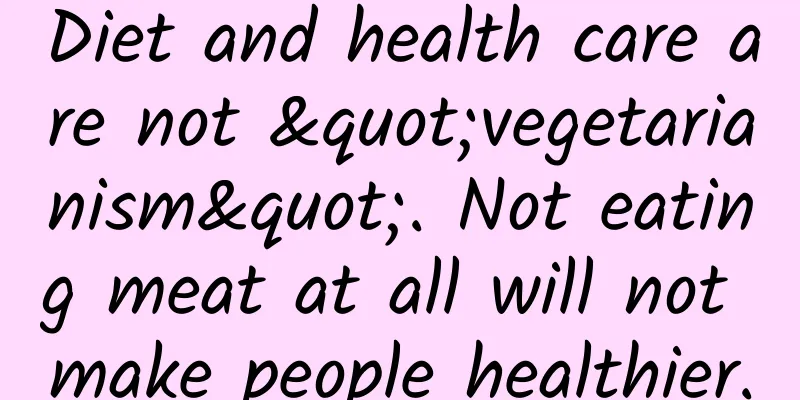Is more milk better after childbirth? If it hurts when touched, beware of mastitis!

|
Author: Li Guangjun, Chief Nurse, Beijing Obstetrics and Gynecology Hospital, Capital Medical University Reviewer: Song Jiangli, Director of the Science Popularization Department of the Chinese Nursing Association As we all know, breast milk is the best food for babies, so many mothers will promote milk secretion by eating various soups and drinks after giving birth, for fear that they do not have enough milk and cannot provide adequate nutrition for their babies. Little do people know that excessive milk may also cause many troubles to postpartum mothers, one of which is postpartum mastitis. 1. Why does excessive milk lead to mastitis? When the postpartum milk secretion is particularly large, if the mother does not let the baby suck in time or the sucking is not sufficient, milk congestion will occur. If the mammary ducts are blocked, some milk will be overfilled and will seep into the surrounding tissues of the mammary glands. Because breast milk also contains substances that can cause inflammation, the body will regard breast milk as a foreign body and develop mastitis. This is one type of non-infectious mastitis. On this basis, if the baby only holds the nipple in his mouth without holding part of the areola in his mouth during sucking, for example, if the posture is incorrect, it may cause nipple cracks. In addition, if the baby does not pay attention to breastfeeding hygiene, bacteria will enter the breast tissue through the cracked nipple, which will cause bacterial infection mastitis. Figure 1 Original copyright image, no permission to reprint At this point, many mothers will ask, if they do not breastfeed after giving birth, will they not get mastitis? In fact, if a mother does not breastfeed her child, she may also develop mastitis. For example, if she does not take milk-reducing medicine in time after giving birth, milk stasis may occur, leading to mastitis. Therefore, mothers who do not plan to breastfeed after delivery should take milk-reducing medicine in time. You can also use some external medicines, such as Glauber's salt. In addition, when the breasts are swollen and milk is secreted, cold compresses can be used to reduce the swelling and blockage of the mammary ducts. This can reduce the risk of mastitis in mothers who do not breastfeed. 2. What are the symptoms of mastitis after childbirth? The most important and basic symptom of postpartum mastitis is local redness, swelling, heat and pain in the breast. Depending on the severity of mastitis, the symptoms may vary. For example, in the early stages, it may be local redness, swelling, heat, and pain. General symptoms, such as fever and general discomfort, are not so obvious. Figure 2 Original copyright image, no permission to reprint If mastitis is not treated promptly or not treated properly, it may gradually develop into an abscess. Once an abscess is formed, the symptoms of general discomfort may worsen. If the abscess grows further and the superficial abscess penetrates the skin, there will be some ulceration on the surface. If the abscess develops further, it may penetrate the pectoralis major muscle and some fatty tissue of the breast, causing an abscess behind the breast. Bacteria can enter the lymph and blood vessels and cause sepsis. Therefore, mastitis must be treated promptly. Once treatment is delayed, the consequences may be more serious. 3. Is it easy to treat mastitis after childbirth? Because the cause of mastitis is relatively clear, in most cases it is due to excessive milk and breast fullness, but the milk ducts are blocked, causing milk to accumulate in the breasts, so it is not difficult to treat. The most important thing is to deal with it in time. If it develops to a particularly serious level, the treatment will take a longer time. Therefore, once symptoms such as redness, swelling, heat, and pain appear, go to the hospital immediately. Depending on the situation, you may need to decide whether to give antibiotics, antipyretics, etc. Figure 3 Original copyright image, no permission to reprint If you only seek treatment when the condition is really serious, for example, if there is already an abscess, it will definitely require incision, drainage, etc. The treatment measures or methods for postpartum mastitis are very clear, so it should not be difficult to treat, but there is a certain degree of recurrence. 4. Will the milk supply decrease after mastitis is cured? Because mastitis causes certain damage to the mammary glands, it may affect the secretion of milk. However, if it is a mild mastitis that does not affect breastfeeding, there will generally not be a significant decrease in milk after the mastitis is cured. If mastitis is very serious, it will affect breastfeeding to a certain extent. The number of breastfeeding must be reduced. Once the number of breastfeeding is reduced, the establishment of the lactation reflex will be reduced, and thus the secretion of prolactin will be reduced, so there will be less milk. Therefore, after mastitis is cured, whether milk production will decrease and to what extent it will decrease depends on the severity of the mastitis, how long the treatment cycle is, and the extent to which it affects breastfeeding. When mastitis is cured, if you find that your milk supply has decreased, you can promote milk secretion through frequent and effective breastfeeding. Frequent nipple stimulation and frequent lactation reflex will increase milk secretion, which is the most important point. Other things, such as a proper diet, adequate rest, and relaxation, can also help promote milk secretion. |
<<: App Annie: Global Mobile App Index Rankings in August 2020
>>: 2020-2021 Global 5G Smartphone Shipment Forecast (with original data table)
Recommend
Bras for small breasts with side breasts
In fact, many people have small breasts, which ma...
Female lower body pictures
Women are one of the most beautiful things in the...
Itchy pimples on the outside of the vagina
The maintenance and cleaning of private parts hav...
Why do patients with chronic kidney disease only need calcium supplementation in the middle and late stages?
Chronic kidney disease (CKD) is in the compensato...
What to do if you have pain under your breast
Breast hyperplasia is one of the common breast di...
Photos of sagging skin at the age of 30
It is said that when women are over 30, they have...
Does sleeping too much or too little make you stupid? JAMA sub-journal study
Sleeping is a science! Recently, scholars from Pe...
What will happen when you are 39 days pregnant?
Women will have different physical changes and re...
How often does a woman menstruate?
Menstrual problems are a rather troublesome issue...
At what age do women experience menopause?
After women enter menopause, they gradually enter...
How to pass the fetal heart monitoring test
When girls do fetal heart monitoring during pregn...
The most difficult days to get pregnant are
Regarding pregnancy, there is a time range that p...
How to remove hair from women's genitals? Five methods of private hair removal
In daily life, there are indeed some women who ar...
How to solve the problem of less business
Low menstrual flow is a problem that many women h...
What foods are forbidden for pregnant women
With the rapid development of the economy, many s...









